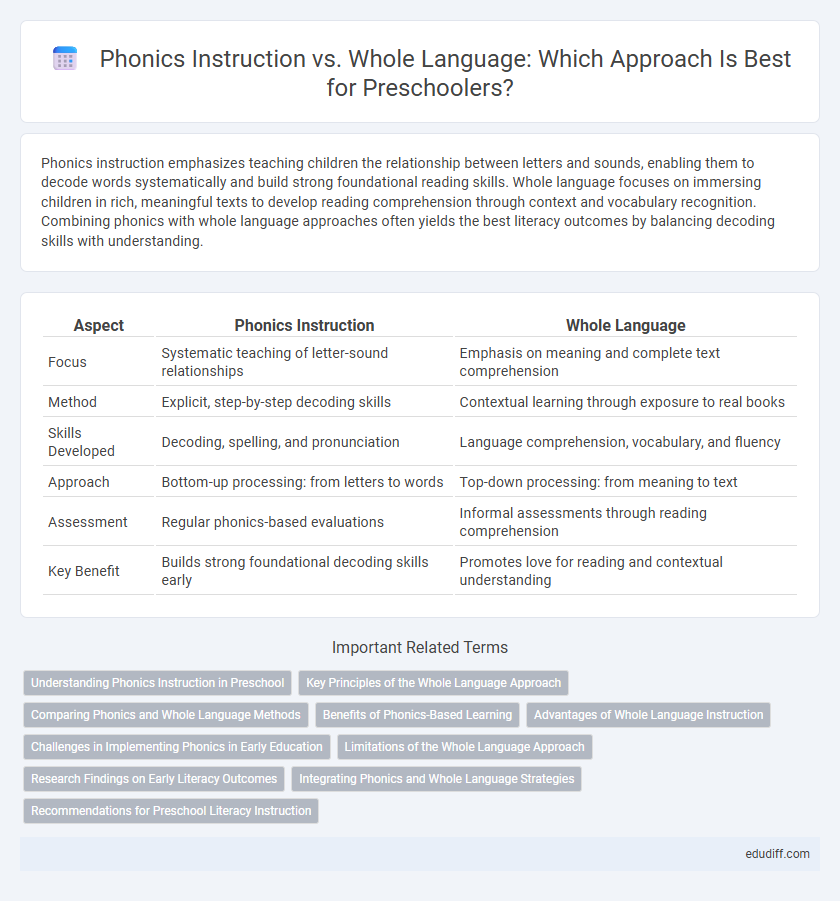Phonics instruction emphasizes teaching children the relationship between letters and sounds, enabling them to decode words systematically and build strong foundational reading skills. Whole language focuses on immersing children in rich, meaningful texts to develop reading comprehension through context and vocabulary recognition. Combining phonics with whole language approaches often yields the best literacy outcomes by balancing decoding skills with understanding.
Table of Comparison
| Aspect | Phonics Instruction | Whole Language |
|---|---|---|
| Focus | Systematic teaching of letter-sound relationships | Emphasis on meaning and complete text comprehension |
| Method | Explicit, step-by-step decoding skills | Contextual learning through exposure to real books |
| Skills Developed | Decoding, spelling, and pronunciation | Language comprehension, vocabulary, and fluency |
| Approach | Bottom-up processing: from letters to words | Top-down processing: from meaning to text |
| Assessment | Regular phonics-based evaluations | Informal assessments through reading comprehension |
| Key Benefit | Builds strong foundational decoding skills early | Promotes love for reading and contextual understanding |
Understanding Phonics Instruction in Preschool
Phonics instruction in preschool emphasizes systematic teaching of letter-sound relationships to build foundational decoding skills crucial for early reading development. Research shows that children exposed to explicit phonics methods demonstrate stronger word recognition and reading fluency compared to whole language approaches. Early phonics instruction supports vocabulary growth and literacy by enabling young learners to decode new words independently.
Key Principles of the Whole Language Approach
The Whole Language Approach emphasizes natural language acquisition through meaningful reading and writing experiences, prioritizing context and comprehension over isolated phonics drills. Key principles include integrating reading with speaking, listening, and writing, promoting a love for literature, and encouraging children to use cues from pictures and story context to decode words. This approach supports holistic language development by fostering authentic communication and intrinsic motivation in preschool learners.
Comparing Phonics and Whole Language Methods
Phonics instruction emphasizes systematic teaching of letter-sound relationships to develop decoding skills, supporting early reading fluency and accuracy. Whole language methods prioritize context and meaning through immersion in authentic texts, fostering comprehension and language appreciation without explicit phonics drills. Comparing these approaches reveals phonics as effective for foundational decoding, while whole language nurtures holistic literacy through natural reading experiences.
Benefits of Phonics-Based Learning
Phonics-based learning enhances early literacy by systematically teaching children the relationship between letters and sounds, improving decoding skills essential for reading fluency. Research demonstrates that phonics instruction supports better word recognition and spelling accuracy compared to whole language approaches. Emphasizing phonemic awareness in preschool prepares children for successful reading development and reduces future reading difficulties.
Advantages of Whole Language Instruction
Whole Language Instruction emphasizes meaningful context and literature-rich environments, supporting natural language development and comprehension skills in preschoolers. This approach fosters a love for reading by integrating reading, writing, speaking, and listening, which enhances overall literacy engagement. Research shows that whole language methods promote critical thinking and creativity, making it an effective strategy for early childhood education.
Challenges in Implementing Phonics in Early Education
Implementing phonics instruction in early education faces challenges such as limited teacher training in systematic phonics methods and resistance due to established whole language approaches that prioritize context and meaning over decoding skills. Young learners often struggle with the abstract nature of phonics rules, requiring tailored, engaging activities to maintain motivation and comprehension. Resource constraints and inconsistent curriculum standards further complicate the widespread adoption of phonics in preschool settings.
Limitations of the Whole Language Approach
The Whole Language approach in preschool often limits phonics instruction, leading to potential gaps in children's ability to decode unfamiliar words and develop foundational reading skills. This method emphasizes context and meaning over systematic phonemic awareness, which can hinder early literacy acquisition for some learners. Research consistently indicates that lack of explicit phonics instruction may result in slower progress in reading fluency and accuracy compared to phonics-based teaching.
Research Findings on Early Literacy Outcomes
Research findings indicate that phonics instruction significantly improves early literacy outcomes by enhancing children's ability to decode words and develop reading fluency. Studies show that systematic phonics approaches lead to better phonemic awareness and spelling skills compared to the whole language method, which emphasizes context and meaning over explicit decoding. Evidence supports integrating phonics within a balanced literacy framework to optimize reading achievement in preschool learners.
Integrating Phonics and Whole Language Strategies
Integrating phonics and whole language strategies in preschool promotes balanced literacy development by combining systematic letter-sound instruction with meaningful reading experiences. Phonics instruction enhances decoding skills, while whole language fosters comprehension and contextual understanding, supporting early readers' ability to recognize words and grasp meaning simultaneously. This blended approach improves reading fluency and encourages a love for reading through varied and engaging literacy activities.
Recommendations for Preschool Literacy Instruction
Phonics instruction emphasizes systematic teaching of letter-sound relationships, which supports early decoding skills essential for preschool literacy development. Whole language approaches prioritize exposure to meaningful text and context, fostering comprehension and a love for reading. A balanced literacy framework that integrates phonics with rich, language-based experiences is recommended to optimize preschoolers' reading readiness and overall literacy outcomes.
Phonics instruction vs Whole language Infographic

 edudiff.com
edudiff.com